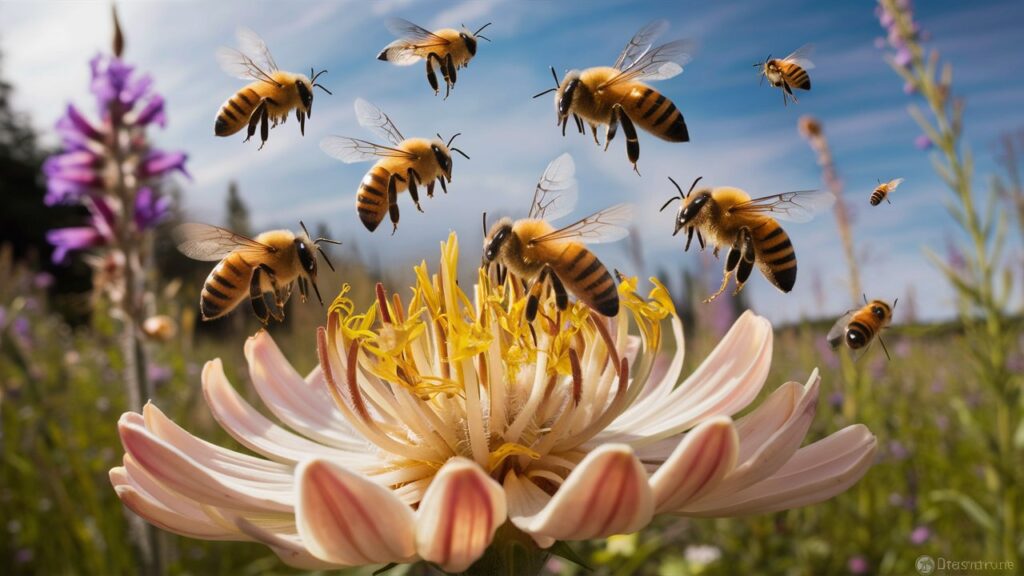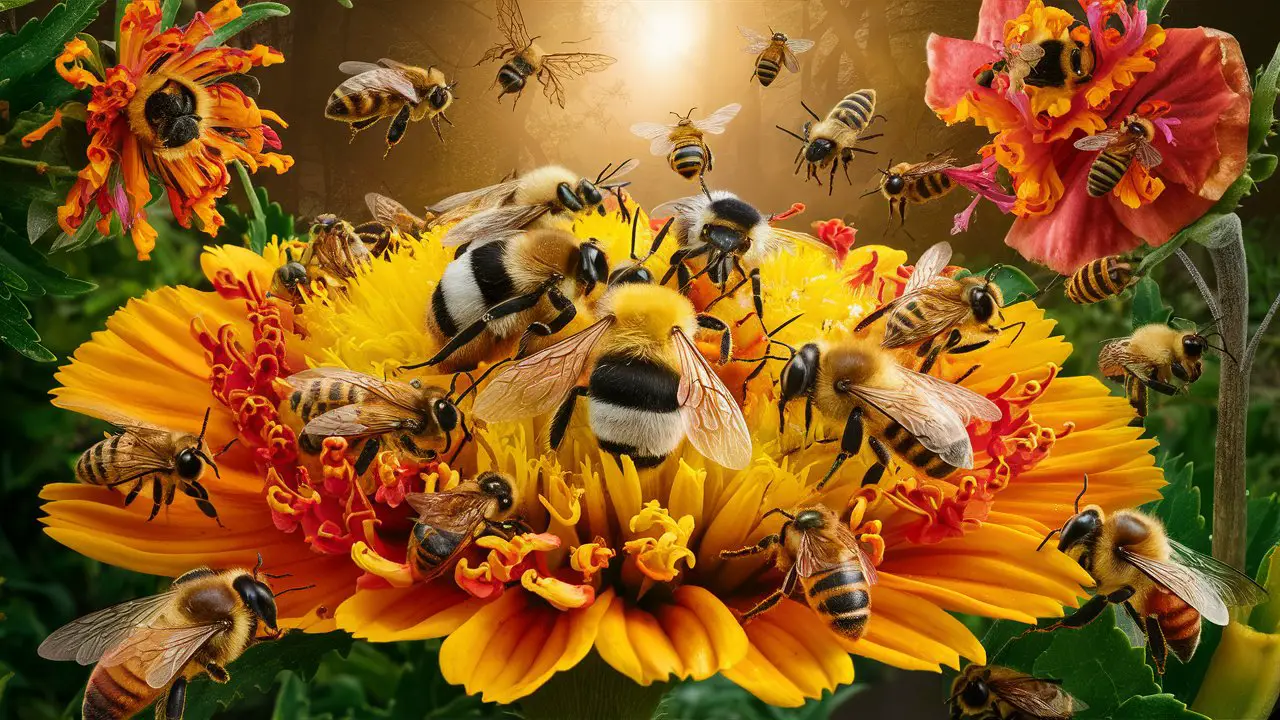As you venture into the garden or walk through the park on a warm, sunny day, the familiar buzzing of bees fills the air. Yet if you pause to observe more closely, you’ll notice that not all bees look or behave the same. In fact, there are over 20,000 species of bees globally, each with distinct traits and behaviors. By learning to recognize key differences, you can begin identifying the most common types you’re likely to encounter. This guide provides an overview of ten widespread bee species, detailing their appearance, nesting habits, food sources, and role as pollinators. Arm yourself with knowledge to appreciate the diversity of bees around you.
The Main Types of Bees
Honeybees
The most well-known type of bee is the honeybee. Honeybees are social insects that live together in large colonies. A honeybee colony typically consists of three types of bees: workers, drones, and a queen. Worker honeybees are sterile females responsible for collecting pollen and nectar, building and repairing the hive, and caring for larvae. The drone honeybees, or male bees, mate with a virgin queen. The queen is the only sexually mature female in the colony and her primary purpose is to lay eggs.
Bumblebees
Bumblebees are social bees that live in small colonies. Unlike honeybees, bumblebee colonies die out at the end of the summer and only the new queens survive the winter. Bumblebees are larger and hairier than honeybees. Bumblebee workers are responsible for collecting pollen and defending the nest. Bumblebee drones mate with virgin queens to reproduce. Bumblebee queens lay eggs and found new colonies in the spring.
Solitary Bees
The majority of bee species lead solitary lives, rather than living in colonies. Solitary bee females construct individual nests and provision them with pollen and nectar for their offspring. Solitary bees include carpenter bees, leafcutter bees, mason bees, and mining bees. These bees are important pollinators of flowers and crops. The life cycle of solitary bees consists of an egg, larva, pupa, and adult. Solitary bees emerge from their nests as adults in the spring or summer, mate, and the females proceed to construct new nests.
In summary, the three main types of bees are honeybees, bumblebees, and solitary bees. While honeybees and bumblebees are social insects that live in colonies, most bee species lead solitary lives. All types of bees, whether social or solitary, play a crucial role as pollinators in the environment.
Honey Bees – The Most Well-Known Pollinators
The Honey Bee Colony
The most familiar bees, honey bees live in large colonies of up to 60,000 individuals. At the center of the colony is the queen bee, whose sole purpose is reproduction. Male drones mate with the queen, while female worker bees maintain the hive.
Complex Social Structure
Honey bee colonies demonstrate a complex social structure and division of labor. Worker bees sequentially take on different roles as they age, starting as cleaners and nursemaids and progressing to foragers. Younger bees remain in the hive, feeding larvae and the queen. Older bees venture out to collect pollen and nectar.
Vital Pollinators
Honey bees are essential pollinators, transferring pollen between flowers as they collect nectar and pollen. A single bee colony can pollinate up to 300 million flowers each day. Their pollination benefits agricultural crops, increasing yields of fruits, nuts, and vegetables. According to some estimates, one third of the human diet comes from crops pollinated by bees.
Threats to Bee Populations
Unfortunately, bee populations have declined significantly in recent decades due to colony collapse disorder, the varroa mite, pesticides, and loss of habitat. The health of honey bee colonies is an important indicator of the state of the environment and sustainability of agricultural systems. Protecting bees and other pollinators is crucial to supporting biodiversity and ensuring food security.
Overall, honey bees are indeed the most well-known and economically valuable pollinators. Despite facing existential threats, honey bees remain integral to maintaining ecological balance and feeding the planet. With conservation efforts, these tiny yet mighty pollinators will continue their essential work.

Bumble Bees – Fuzzy and Fast-Flying
Bumble bees are one of the most recognizable types of bees. They are known for their large, fuzzy bodies and fast, seemingly uncoordinated flying. Unlike the slender honey bee, bumble bees have a rounded abdomen and thorax covered in dense hair.
Bumble bees are social insects that live in small colonies, typically with fewer than 100 members. They construct nests in cavities such as abandoned rodent nests, grass tussocks, or compost heaps. Bumble bee colonies have a short lifespan and die out at the end of the growing season in the fall.
Distinctive Coloration
Bumble bees display a variety of colors and patterns, from the rusty red of the common eastern bumble bee to the bright yellow and black of the American bumble bee. Their distinctive coloration acts as a warning to potential predators that they may sting if provoked. Bumble bees are generally non-aggressive, however, and will only sting in defense of their colony.
Important Pollinators
Like other bees, bumble bees are important pollinators for wildflowers and domesticated crops. They forage for pollen and nectar, carrying pollen grains on their hairy bodies from flower to flower as they feed. Bumble bees are excellent pollinators of plants like tomatoes, peppers, and blueberries. Their ability to “buzz pollinate” flowers by vibrating their flight muscles dislodges pollen from the anthers.
Bumble bees begin foraging earlier and end later in the day than most other bees, and they continue foraging during light rain and lower temperatures when other bees remain in the hive. Their long tongues allow them to access nectar in flowers with deep corollas that other bees cannot reach. The contributions of bumble bees to the pollination of native plants and agricultural crops highlight the importance of conserving these essential pollinators.
Solitary Bees – The Loners of the Bee World
As social as honey bees can be, solitary bees prefer to operate independently. Unlike honey bees that live in large colonies, solitary bees live alone in the wild. As their name suggests, solitary bees do not form colonies or social groups. Instead, fertile females construct nests for their young on their own.
Nesting Habits
Solitary bees nest in small cavities they find in nature, such as hollow plant stems, holes in wood, or tunnels in the ground. The female bee provisions each cell in her nest with nectar and pollen before laying an egg inside and sealing off the cell. She repeats this until her nest is full, then seals the entrance to the nest. The eggs hatch into larvae, feed on the provisions, pupate, and emerge as adults.
Important Pollinators
Although solitary bees tend to be less efficient pollinators than social bees on a per bee basis, their large numbers and diversity have a huge impact on pollination. Many plants actually depend solely on solitary bees for pollination. The pollination services provided by solitary bees are estimated to be worth billions of dollars annually to agricultural economies worldwide.
Conservation Concerns
Many solitary bee species are experiencing population declines due to habitat loss, pesticides, and climate change. Providing suitable nesting habitats, reducing pesticide use, and planting pollen and nectar sources can help support populations of these important pollinators. Protecting patches of undisturbed land and creating wildlife corridors are also beneficial for connecting solitary bee populations.
By understanding the unique life cycle and habits of solitary bees, you can appreciate their vital role as pollinators and work to provide the habitat and resources they need to thrive. Though they prefer to operate alone, solitary bees are invaluable members of ecological communities and deserve the same conservation efforts as their more social bee counterparts.
Stingless Bees – Gentle Pollinators
Stingless bees, also known as meliponines, are a group of bees that do not have a stinger to defend themselves or their nest. There are over 500 species of stingless bees found in tropical and subtropical regions around the world. Unlike honey bees that live in hives, stingless bees live in small colonies inside tree hollows or cavities.
Small but Mighty Pollinators
Although stingless bees are tiny, around 2 to 3 millimeters in length, they are excellent pollinators. They forage on a wide range of flowers and plants. Their small size allows them to access flowers with small openings that most bees cannot reach. Stingless bees are also less aggressive than honey bees, so they do not deter other pollinators away from plants and flowers. Their gentle nature and vibrant buzzing activity make them pleasant visitors to gardens and farms.
Produce Nutritious Honey
Some species of stingless bees, such as Tetragonula carbonaria and Austroplebeia australis, produce honey that is stored in small ceramic pots inside their nests. Stingless bee honey is highly nutritious and medicinal. It contains higher levels of moisture, fructose, amino acids, and antioxidants compared to honey bee honey. The honey is harvested sustainably by beekeepers and supplied to local communities as a natural sweetener and remedy.
Important Ecological Role
Although stingless bees nest in small colonies, they play an important role in the environment. Their pollination services help maintain biodiversity in forests and promote the growth of native plants. Unfortunately, stingless bee populations are declining due to deforestation, climate change and competition from invasive honey bees. Protecting native stingless bees and providing suitable nesting habitats are critical to ensuring they continue fulfilling their ecological purpose.
In summary, stingless bees are gentle, hardworking pollinators that produce nutritious honey and play an integral role in the health of our ecosystems. Conserving these tiny but mighty bees will benefit both nature and humankind.
Download Now!

Conclusion
You have now learned how to recognize the most common species of bees. With this guide, you can confidently identify honeybees, bumblebees, carpenter bees, and mason bees. The next time you see bees buzzing around flowers in your garden or neighborhood, put your new knowledge to work. Look closely at their size, color patterns, nesting habits and behaviors to determine what type of bee you’re observing. Being able to tell different bees apart will give you a deeper appreciation for the diversity of these important pollinators. Use this guide as a reference and enjoy getting to know your local bee species better.





